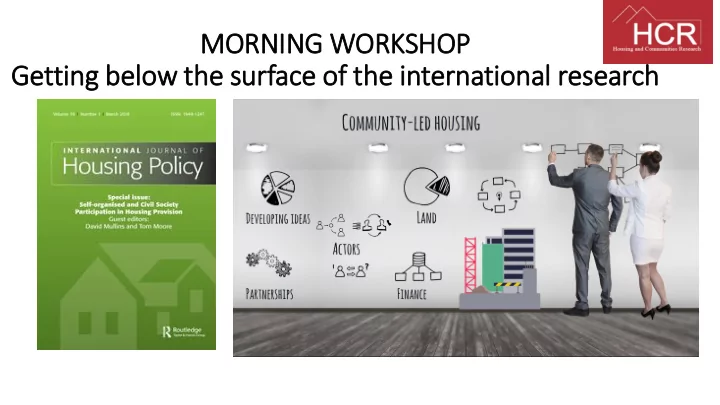

MORNING WORKSHOP Getting below the surf rface of f the in international research
What are the key questions asked by in international research on coll llaborative housing? • ‘Collaborative housing in 10 countries – variety of forms and types of analysis • ‘Why’ questions • Why the resurgence? - about more than GFC • Varied social origins and evolution in different societies • Fewer ‘who’ questions ! • How much do we know about who participates in CH? • Is there a ‘civic core’ effect? • Several ‘how questions’: • Role of external partners in supporting self-organisation • Multi-level field model for CH promotion • Identifying key resource dependencies of CH projects • Crucial but intermittent role of public policy • Life-cycles of fields and organisations – scaling-up outcomes? • A few of these how questions from IJHP and beyond to be reality checked in this workshop
Role of f ext xternal partners in in supporting self lf- organisation - • Replication through Partnership - Tom Moore Partnerships are often facilitated by, and emerge from, the crucial support given by CLH hubs/enablers. Enablers often act as an important conduit and mediator of the Costs and benefits of CLTs collaborating with large relationship (Moore and Mullins, 2013). housing providers • Partnerships are an effective way of scaling up and out CLH activity & of working to Contrasting independent and partnership routes to provide social good with actors that share CLT growth similar values – potential unlocking resources and opportunities for both partners that would not otherwise be there. //methods of replication through self-help and mutual exchange – CLH regional umbrellas in England • There is no ‘one size fits all’ model – of CLH or of partnerships. Transplanting learning from one community to another may not work; instead partnerships need be negotiated in relation to local circumstances, relationships, ambitions, needs and priorities.
Role of f ext xternal partners in in supporting self lf- ! ! organisation (2 (2) ! WIDER+ ENVIRONMENT+ Market+ State+ SECONDARY+ Analysing multi-stakeholder STAKEHOLDERS+ collaboration - Darinka Czischke PRIMARY+ STAKEHOLDERS+ CH as co-production PS# 2# PS# 1# COLLABORATIVE+ Mapping primary and secondary HOUSING+ PROJECT+ SS# 1# stakeholders and wider environment of CH projects PS# 2# Practical analytical tool for comparative research: Vienna and Lyon case study examples WES# 1# Civil+ society+
Five Pillars of f Collaborative Housing – Bingzi He • Origins in resource dependency theory and CH literature review/Delphi panel • Five pillars without which CH projects cannot succeed • How are these pillars accessed in two very different societies and policy contexts • How are CH pillars distinct from market or welfare housing pillars? • How the framework can be tested through qualitative case studies and quantitative methods • What does this add to knowledge?
Multi-Level Model of f CH Promotion Fields – Richard Lang
The role of the State Welfare regimes and organisational The policy cycle & search for fields – Lang & Stoeger sustainability – Mullins Policy can create How to be • Importance of institutional context Sustainable crucial but after state intermittent for CH intervention Precursors ends opportunities for CH • Role of partnerships and links to adjacent fields Political/ Legacy and Policy Sustainability Window • Large scale coops • Local authority planning and land How to stimulate state action • Developer competitions • Importance of political stability Impact and Technical Outcomes Issues Policy How to Enactment demonstrate social impact
Organisational Life Cycles and Field ecology What happens when CH succeeds and Does this create new spaces for grass becomes institutionalised? – Sorvoll roots organisations to reclaim? and Bengtsson • English HAs scaled up 1970s-2000s • ‘pyrrhic victory of civil society • Large scale new build housing’ • Largely abandoned street properties • Post-war Success of coops in and housing renewal Scandinavia • Asset disposals • But gradual move from civil society • Created the space for ‘self -help roots to market housing’ and community stewardship • Logic of competition and growth • What are the trade-offs?
Collaborative housing research (1990 – 2017) A systematic literature view Richard Lang│ richard.lang@jku.at Claire Carriou Darinka Czischke
Aim and method Paper under review with “Housing, Theory and Society” (R&R) and part of Special Issue Systematic review of relevant peer-reviewed journal articles published in English, German and French over the period of 1990 – 2017 Articles were inductively synthesised and categorised into major themes and sub-themes 195 articles (conceptual, empirical, reviews, editorials) from different disciplines (e.g. housing, planning, development, architecture, social work) Five thematic clusters: socio-demographic, collaboration, motivation, effects and context
Who lives and engages in Collaborative housing? Thematic� area� First-order� theme� Theme� description� /� Emerged� Number� (listed� by� year� of� explanation� of� emergence� papers� alphabetically)� Socio- Middle� class� CH� reflecting� the� socio- 1992� 5� demographic� economic� interests� of� middle� perspective� classes� Working� class� CH� involving� people� with� 1992� 6� working� class� backgrounds� Low� income� CH� targeting� people� with� 1993� 3� households� lower� incomes� Gender� CH� from� a� gender� perspective� 1997� 7� Seniors� CH� created� for� and/or� 2002� 25� managed� by� elderly� � Youngsters� and� Young� people� and� families� 2004� 10� families� engage� and� live� in� CH� � Intergenerational� CH� for� resident� groups� of� 2007� 8� mixed-age�
Key Questions for Discussion • Are these the key messages from international research on collaborative housing? • How do they resonate with the worlds of activism and policy? • What are the gaps? • Should research just focus on the how questions or are the why and who questions more fundamental?
Recommend
More recommend